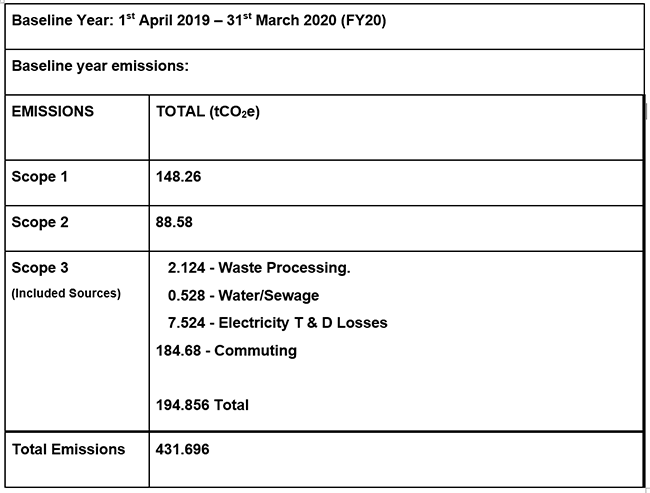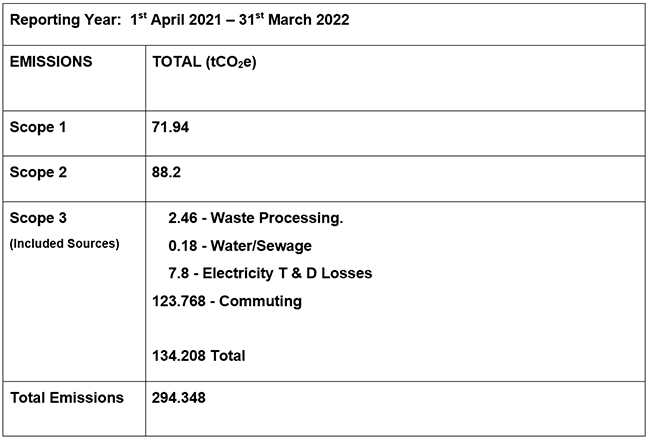Steatite Ltd is committed to achieving Net Zero emissions by 2050.
Steatite - Carbon Reduction Plan

Baseline Emissions Footprint
Baseline emissions are a record of the greenhouse gases that have been produced in the past and were produced prior to the introduction of any strategies to reduce emissions. Baseline emissions are the reference point against which emissions reduction can be measured.

Current Emissions Reporting

Emissions Reduction Targets
Please note the current emissions listed above include 38.88 tCO2e from a company that was acquired after the baseline year.
We are also bringing into our carbon reporting for the year ended 31st March 23, emissions from:
- Work from Home
- Business miles in private vehicles
- Freighting goods (from calculations done so far it looks as if this alone will be in the region of 290 tCO2e so will change the reporting significantly).
In order to continue our progress to achieving Net Zero, we have adopted the following carbon reduction strategy.
Short-term Strategy to carbon reduction is to Reduce Consumption, Reduce Waste.
Consistent with this approach we will:
- Minimise CO2e from electricity use by:
- switching electrical equipment off when there is no business benefit to leaving it on,
- Considering the environmental impact of new electrical equipment unless there are other compelling business reasons not to do so.
- Minimise CO2e from gas use by ensuring that the temperature in our workplaces is adequate but not excessive, and any warm-up times are reasonable.
- Minimise CO2e from use of company vehicles by:
- Reducing Average CO2e emissions of the fleet,
- Reducing the amount of company miles travelled by considering other alternatives to travel where feasible.
- Minimise CO2e from processing of waste by applying the waste hierarchy.
- Minimise CO2e from airfreight by working with our customers to move from airfreight to sea freight where lead-times / other operational constraints allow or purchase closer to the business unit where there are viable options.
Note 1: Moving from airfreight to sea freight also provides a financial dividend that can benefit both the company and its customers.
We will continuously challenge the status quo and look for other opportunities to reduce wasted energy.
Medium-term Strategy.
- Company Vehicle Use (Scope 1 wholly owned)
All new company vehicles will be battery powered unless operational constraints make this unworkable. As the Government has committed to the grid being green by 2035 this will ensure that emissions from company vehicles will be zero from that date.
Note 2: USA commitment for 100% percent carbon pollution-free electricity by 2035 (FACT SHEET: President Biden Sets 2030 Greenhouse Gas Pollution Reduction Target Aimed at Creating Good-Paying Union Jobs and Securing U.S. Leadership on Clean Energy Technologies – The White House.
Note 3: The UK Government is committed to the grid being green by 2035 so carbon from electricity will be removed from that date (Plans unveiled to decarbonise UK power system by 2035 – GOV.UK (www.gov.uk)).
- Gas Use (Scope 1 wholly owned)
If there is no low carbon alternative for gas for heating by 2035, we will change to electric heating in all Business Units.
Note 4: We believe that at current energy costs moving from gas to heat pump heating will result in similar running costs, but more work needs to be done to confirm this.
Note 5: There will be upfront costs for the removal of gas systems and the installation of heat pumps.
- Electricity Use (Scope 2 wholly owned)
The UK and US Governments have committed to the respective grids being green by 2035 so carbon from electricity will be removed from those dates.
Providing the UK and US governments meet their commitments our Mid-term strategy will result in our scope 1 and 2 emissions being eliminated by 2035.
Long-term strategy.
- Freighting Goods (Scope 3 shared)
This is currently predicted to be one of our largest emissions. Although leading freight carriers, such as DHL, are making great strides in decarbonising their processes e.g., battery vehicles, cleaner fuel for aircraft, etc., there is still great uncertainty in this area. There is currently no clear path to net 0 by 2050 although as new technologies and cleaner fuels emerge this may change.
We will diversify our supply chain to open up new opportunities and work with all our partners to reduce carbon. We will continue to keep an open mind and review new options including the use of carbon offsets as they arise to meet our commitment to net 0 by 2050.
- Commuting
The vast majority of our employees currently commute by car. By 2050 only cars older than 20 years will still be non-electric. Where this is the case, we will consider taking actions to share the responsibility with the employees concerned including the use of carbon offsets to meet our commitment to net 0 by 2050.
- Business miles in private vehicles (Scope 3 shared)
We currently predict that we have a relatively small footprint in this area. After 2040 we will only authorise business miles in private vehicles where the private vehicle is electric.
- Waste Processing (Scope 3 shared)
Waste processing currently amounts for a very small proportion of our overall emissions.
We will diversify our supply chain to open up new possibilities and work with all our partners to reduce the amount of waste in our supply chain. We will continue to keep an open mind and review new options as they arise to reduce waste.
We will continue to look for further opportunities to segregate new recyclable streams from our general waste. If these actions don’t achieve zero carbon we will consider all options available to us including the use of carbon offsets, to meet our commitment to net 0 by 2050.
- Water / Sewage processing (Scope 3 shared)
Although water use /sewage processing currently amounts for the least proportion of our overall emissions due to the fact that none of our business units use water in their processes, we will ensure water is not wasted by applying our objective of Reduce Consumption, Reduce Waste. We will continue to identify ways to share the responsibility for any residual carbon emissions including the use of carbon offsets as to meet our commitment to net 0 by 2050.
We project that carbon emissions will decrease over the next five years from 294.348 tCO2e to 209.281 tCO2e by FY2028. This is a reduction of 85.067 tCO2e 28.9% on the FY22 level. Please note, this is based on the emissions we are currently reporting on and will change significantly when the additional emissions mentioned earlier are brought into the carbon accounting system.
Progress against these targets can be seen in the graph below:
Please note the chart below will change significantly when the additional emissions are brought into the carbon accounting.
The step change in 2035 is when we move from gas to electric heating (if there is no viable low carbon alternative to gas), and the levelling out of the target in FY22 is when 38.88 tCO2e from a company that was acquired after the baseline year was added in to the plan.

Carbon Reduction Projects
Completed Carbon Reduction Initiatives
The following environmental management measures and projects have been completed or implemented since the 2000 baseline. The carbon emission reduction achieved by these schemes equate to 137.352 tCO2e, a 32% reduction against the 2000 baseline. Although the improvements recorded above have been seen it is not certain that they all come from the actions we have taken and the pandemic will inevitably have contributed to the improvements.
Since 2020 we have introduced LED Lighting, Electric and Hybrid electric cars to the fleet. We have also introduced 4 days/week working in one of our business units to reduce the amount of warm up periods of the gas heating system. We have also introduced sub metering of electricity use to give us better control and help us identify and reduce any wasted electric. We define wasted energy as anything that consumes energy that doesn’t bring a business benefit.
We operate an Environmental Management system certified to ISO14001 by UKAS accredited certification bodies. It is intended to align our carbon accounting with ISO14064-1, although this has not yet been completed.
Declaration and Sign Off
This Carbon Reduction Plan has been completed in accordance with PPN 06/21 and associated guidance and reporting standard for Carbon Reduction Plans.
Emissions have been reported and recorded in accordance with the published reporting standard for Carbon Reduction Plans and the GHG Reporting Protocol corporate standard[1] and uses the appropriate Government emission conversion factors for greenhouse gas company reporting[2].
Scope 1 and Scope 2 emissions have been reported in accordance with SECR requirements, and the required subset of Scope 3 emissions have been reported in accordance with the published reporting standard for Carbon Reduction Plans and the Corporate Value Chain (Scope 3) Standard[3].
This Carbon Reduction Plan has been reviewed and signed off by the board of directors (or equivalent management body).

